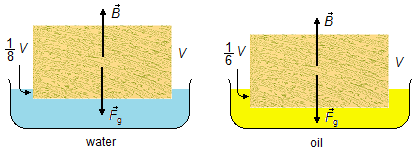Solved Problem on Fluid Mechanics
advertisement
A solid float in the water with 1/8 of its volume immersed. The same body floats in oil with 1/6 of its volume immersed. Determine the ratio of the density of oil ρo to the density of water ρw.
Problem data:
- Fraction of the volume of the body immersed in water: \( \dfrac{1}{8}V \);
- Fraction of the volume of the body immersed in oil: \( \dfrac{1}{6}V \).
When the body is immersed in water \( \dfrac{1}{8} \) of its volume, it sinks displacing a mass of water equal to the mass of the entire body, the buoyant force and the gravitational force are in equilibrium (Figure 1).

When the body is immersed in oil \( \dfrac{1}{6} \) of its volume it sinks displacing a mass of oil equal to the mass of the whole body, the buoyant force and the gravitational force are in equilibrium.
Solution
As the body is in equilibrium, the gravitational force \( {\vec F}_{g} \) and the force of buoyancy \( \vec B \) cancel out.
\[
\begin{gather}
B=F_{g} \tag{I}
\end{gather}
\]
The buoyant force is given by
\[
\begin{gather}
\bbox[#99CCFF,10px]
{B=m_{L}g} \tag{II}
\end{gather}
\]
where mL is the mass of water displaced.The density of a body is given by
\[
\begin{gather}
\bbox[#99CCFF,10px]
{\rho=\frac{m}{V}} \tag{III}
\end{gather}
\]
\[
\begin{gather}
m=\rho V \tag{IV}
\end{gather}
\]
Using expression (IV) the mass of liquid displaced will be
\[
\begin{gather}
m_{L}=\rho_{L}V_{L} \tag{V}
\end{gather}
\]
substituting expression (V) into expression (II)
\[
\begin{gather}
B=\rho_{L}V_{L}g \tag{VI}
\end{gather}
\]
- Body floating in water:
\[
\begin{gather}
B=\rho_{w}\left(\frac{1}{8}V\right)g \tag{VII}
\end{gather}
\]
substituting expression (VII) into expression (I)
\[
\begin{gather}
\frac{1}{8}\rho_{w}Vg=F_{g} \tag{VIII}
\end{gather}
\]
- Body floating in oil:
\[
\begin{gather}
B=\rho_{o}\left(\frac{1}{6}V\right)g \tag{IX}
\end{gather}
\]
substituting expression (IX) into expression (I)
\[
\begin{gather}
\frac{1}{6}\rho_{o}Vg=F_{g} \tag{X}
\end{gather}
\]
Equating the expressions (VIII) and (X)
\[
\frac{1}{8}\rho_{w}\cancel{V}\cancel{g}=\frac{1}{6}\rho_{o}\cancel{V}\cancel{g}
\]
canceling the volume V and acceleration due to gravity g on both sides of the equation
\[
\begin{gather}
\frac{1}{8}\rho_{w}=\frac{1}{6}\rho_{o}\\
\frac{\rho_{o}}{\rho_{w}}=\frac{6}{8}
\end{gather}
\]
\[ \bbox[#FFCCCC,10px]
{\frac{\rho_{o}}{\rho_{w}}=\frac{3}{4}}
\]
Note: Oil density will be 0.75 of water density or 75% of water density (less dense). The
body sinks deeper in oil because it is less dense than water, therefore, it produces less buoyant force.
advertisement

Fisicaexe - Physics Solved Problems by Elcio Brandani Mondadori is licensed under a Creative Commons Attribution-NonCommercial-ShareAlike 4.0 International License .